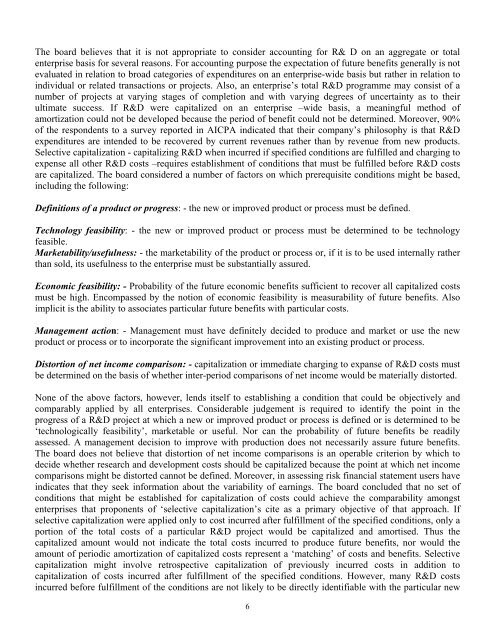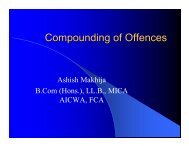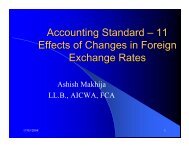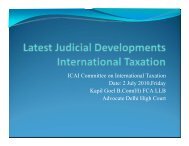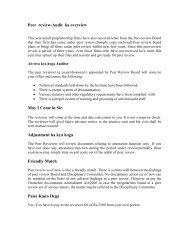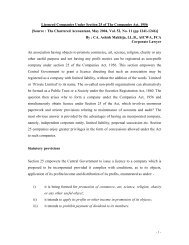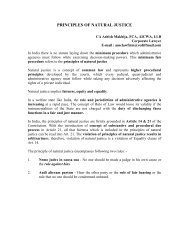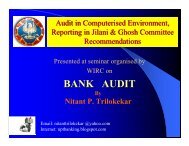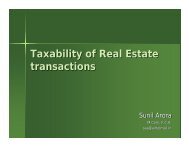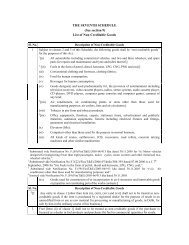dsrawat, fca intangible assets
dsrawat, fca intangible assets
dsrawat, fca intangible assets
Create successful ePaper yourself
Turn your PDF publications into a flip-book with our unique Google optimized e-Paper software.
The board believes that it is not appropriate to consider accounting for R& D on an aggregate or totalenterprise basis for several reasons. For accounting purpose the expectation of future benefits generally is notevaluated in relation to broad categories of expenditures on an enterprise-wide basis but rather in relation toindividual or related transactions or projects. Also, an enterprise’s total R&D programme may consist of anumber of projects at varying stages of completion and with varying degrees of uncertainty as to theirultimate success. If R&D were capitalized on an enterprise –wide basis, a meaningful method ofamortization could not be developed because the period of benefit could not be determined. Moreover, 90%of the respondents to a survey reported in AICPA indicated that their company’s philosophy is that R&Dexpenditures are intended to be recovered by current revenues rather than by revenue from new products.Selective capitalization - capitalizing R&D when incurred if specified conditions are fulfilled and charging toexpense all other R&D costs –requires establishment of conditions that must be fulfilled before R&D costsare capitalized. The board considered a number of factors on which prerequisite conditions might be based,including the following:Definitions of a product or progress: - the new or improved product or process must be defined.Technology feasibility: - the new or improved product or process must be determined to be technologyfeasible.Marketability/usefulness: - the marketability of the product or process or, if it is to be used internally ratherthan sold, its usefulness to the enterprise must be substantially assured.Economic feasibility: - Probability of the future economic benefits sufficient to recover all capitalized costsmust be high. Encompassed by the notion of economic feasibility is measurability of future benefits. Alsoimplicit is the ability to associates particular future benefits with particular costs.Management action: - Management must have definitely decided to produce and market or use the newproduct or process or to incorporate the significant improvement into an existing product or process.Distortion of net income comparison: - capitalization or immediate charging to expanse of R&D costs mustbe determined on the basis of whether inter-period comparisons of net income would be materially distorted.None of the above factors, however, lends itself to establishing a condition that could be objectively andcomparably applied by all enterprises. Considerable judgement is required to identify the point in theprogress of a R&D project at which a new or improved product or process is defined or is determined to be‘technologically feasibility’, marketable or useful. Nor can the probability of future benefits be readilyassessed. A management decision to improve with production does not necessarily assure future benefits.The board does not believe that distortion of net income comparisons is an operable criterion by which todecide whether research and development costs should be capitalized because the point at which net incomecomparisons might be distorted cannot be defined. Moreover, in assessing risk financial statement users haveindicates that they seek information about the variability of earnings. The board concluded that no set ofconditions that might be established for capitalization of costs could achieve the comparability amongstenterprises that proponents of ‘selective capitalization’s cite as a primary objective of that approach. Ifselective capitalization were applied only to cost incurred after fulfillment of the specified conditions, only aportion of the total costs of a particular R&D project would be capitalized and amortised. Thus thecapitalized amount would not indicate the total costs incurred to produce future benefits, nor would theamount of periodic amortization of capitalized costs represent a ‘matching’ of costs and benefits. Selectivecapitalization might involve retrospective capitalization of previously incurred costs in addition tocapitalization of costs incurred after fulfillment of the specified conditions. However, many R&D costsincurred before fulfillment of the conditions are not likely to be directly identifiable with the particular new6


